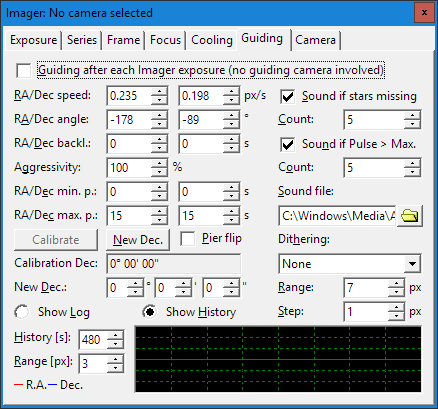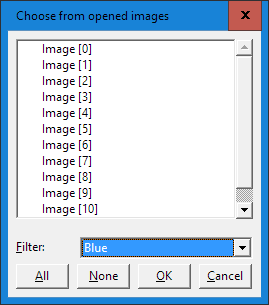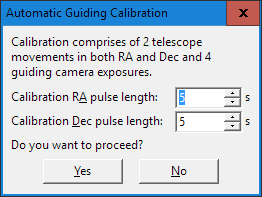Inter-image guiding
This new feature is designed for modern mounts, which are
precise enough to keep tracking with sub-pixel precision through
the single exposure, and irregularities only appear on the
multiple-exposure time-span. Such irregularities are caused by
many sources (polar misalignment, differences in refraction
calculations, mount and telescope mechanical deformation etc.) and
cannot be completely avoided. Inter-image guiding then performs
slight mount position fixes between individual exposures of the
main camera, which eliminates “traveling” of the observed
objects through the detector area during observing session.
Because this guiding method uses main imaging camera,
it does not use another guiding camera and naturally does not
need neither OAG nor separate guiding telescope to feed the
light into it. This also brings another consequences:
The Guide using: Guiding camera/Telescope
option is missing from inter-image guiding setup, as the
inter-image guiding always use Telescope PulseGuide
interface. If the particular telescope driver is not equipped
with such interface, inter-image guiding cannot be used.
Especially older mounts often rely on the “Autoguider
port” only and thus require the opposite port, typically
offered by the guider camera. But such mounts are often not
capable to keep tracking for any reasonable long exposure
without regular guiding, so this limitation is not that
important. The Position detection: Brightest star/Plate
solution is also missing as the guiding method is always
Plate solution. This means stars are searched within
the whole image and matched with the stars on the reference
frame (reference frame is the first frame taken after the
inter-image guiding is turned on). This method results into more
reliable guiding compared to brightest star method, as the
mutual offset between frames is calculated as an average of
offsets of all detected and matched stars. Brightest star method
also requires frame cropping around the chosen star, which is
naturally not possible in the case of the main
camera. Hint: It is necessary to detect at last 3 stars
within the image to be able to use Plate match. If less stars
can be detected, this method of guiding cannot be
used.
Inter-image guiding parameters are in the Guiding
tab of the Imager Camera tool.

Inter-image guiding controls are available in the newly
introduced Guiding tab of the Imager Camera tool
window Similarly to regular guiding, also the inter-image guiding
requires calibration. The only difference is the inter-image
guiding calibration does not use predefined exposure time and read
mode, but offers entering of exposure time for calibration only,
as the normal imaging camera exposure time could be hundreds of
seconds and the calibration would take very long time.
Also alarms for missing stars in the image and too long
calibration pulse are present.
Hint: The “missing stars” alarm can be very effectively
used also for weather monitoring. If some clouds appear and the
stars cannot be found on the image, SIPS can alert (wake-up) the
observer. New features
Many smaller-scale enhancements and updates were added into
SIPS v2.4.3.
Image zooming
Images could be easily zoomed simply using mouse wheel
within SIPS. The “zoom slider” GUI tool for image zoom,
also used for presetting of the zoom value when new image was
opened or downloaded from the camera, was located in the
Image Transform tool. This was not very intuitive, as
the Image Transform tool offers operations, which
alters the image bitmap itself and image zoom affects only how
images are displayed. Also it was pretty difficult to find
this zoom slider for new users, as the number of available
tool windows is pretty high in SIPS.
This is why the new version of SIPS removed the zoom slider
from the Image Transform tool and placed it directly
into the tool bar. It is always visible and the zoom slider
position also reflects mouse wheel rotation over any
image.

Zoom slider in the SIPS main tool-bar Image pick-list
SIPS allows reusing of already opend/processed images
beside opening new images from files on disk. The Image Pick
List dialog box was extended with the ability to select and
un-select all images as well as to select images based on the
filter used.
Hint: The Pixels pick list always contained the ability to
select images by mouse drags and also supported
<Ctrl><A> hot key for selection of all images, but
now this functionality is available with one mouse click
only. 
New image pick list dialog box Guider calibration
The Guiding Camera tool window parameters defining
calibration pulse lengths are necessary only upon guider
calibration. So these two parameters were moved to a modal
dialog box, opened prior to calibration sequence. This
somewhat reduced the complexity (and size) of the Guider
Camera tool window itself.

Dialog box opened prior to guider camera
calibration sequence FITS header updates
New SIPS version slightly modified the used FITS headers to
comply with the latest FITS standards.
The DATE-OBS and TIME-OBS headers, each containing the date
“yyyy-mm-dd” and time “hh:mm:ss” strings,
representing the beginning of the exposure, were replaced with
single DATE-OBS header containing both date and time in the
form of “yyyy-mm-ddThh:mm:ss.sss” string. The TIME-OBS
header was removed.
Hint: The alternative UT header exists with the same
information. Also DATE-BEG and DATE-END headers can be used,
stating begin and end time of exposure. These two headers were
introduced to clear some confusion whether the DATE-OBS marks
the time of the exposure begin or center. New FITS header JD was introduced instead of the removed
TIME-OBS header. The JD contains the same time like DATE-OBS
or DATE-BEG, but expressed as single double-precision floating
point number expressing the Julian date of the exposure
begin.
Photometry tool
While the Photometry tool is still marked
“beta”, as it still does not contain astrometry based
photometry, it was fixed to be usable for regular photometry
measurements and light curve plotting/storing based on mutual
match of images of the single observing night and manual
marking of variable, comparison and possibly check stars.
Bug fixes
Warning: SIPS version 2.4.2 introduced parallel processing of
image set calibration on the multi-core processors. Unfortunately
the calibration of some images could be skipped on the systems
with multiple cores. The resulting set could contain images, from
which the dark frame was not subtracted and flat field frame was
not applied. This bug was fixed within a few days and version
2.4.3 was released. If the SIPS is used for image
calibration and version 2.4.2 is installed, update to version
2.4.3 is strongly recommended. The new version fixed the problem with naming of files saved
from the Series tab of the Imager Camera tool
window. Because the Series tab defines only some
exposure parameters (exposure time, filter and binning), other
parameters are used as defined in the Exposure tab for
individual exposure types. And while the Series tab
allows taking of various exposure types (light, dark, ...), the
parameters defined in the Exposure tab were not used
according to exposure type defined in the series table, but
according to exposure type currently selected in the
Exposure tab.
Some updates were introduced into 64-bit version to fix
possible structure and class sizes with respect to default packing
in the 64-bit execution mode. This should increase the 64-bit SIPS
version stability.
SIPS is a freeware and can be downloaded from the Download section of this web site.
| 